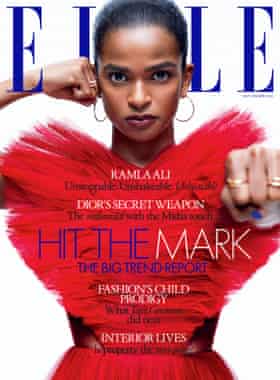September fashion glossies hail the arrival of a post-lockdown roaring 20s

Vogue, Harper’s and Elle turn the spotlight on razzle dazzle and bright colours as we emerge from Covid gloom
In an unusual move, the cover of British Vogue features the time the photograph on it was shot: 4.57am. The image, of actor and activist Gemma Chan reclining on a boat on the Thames as the sun rises, is symbolic of a new dawn in this September’s glossy magazines. The biggest, bulkiest and most important of the year, they signal what can be expected in the industry in the months ahead. This year, though, they herald not just a new season but what can be expected from post-pandemic dressing (even if the pandemic isn’t yet fully in the rear-view mirror).
From Vogue to Elle and Harper’s Bazaar, this year’s offering, which is slimmer on the ground than in recent years, since Marie Claire stopping print in 2019 and Katy Grand exited Love Magazine last year, seem to be on the same page in terms of laying out new sartorial spirit. Now is the time, they say, for sequins and silver and dressing up for parties and going out-out rather than dressing down for sofas. Just as, after the first world war and the 1918 flu pandemic, the 1920s brought flappers and flamboyance, this new dawn is the 21st century’s own roaring 20s. And the vibe is one of hedonism and creativity after the Covid restrictions caused stasis and the rise of elasticated waists.
The mood, says Elle, is “pile it on”. The moment is now to “embrace outrageous overdressing” and “tell subtle to clear off”. In Harper’s Bazaar, stylist Miranda Almond writes that the current trend for all things “razzle dazzle” is about “throwing off the past year’s doom and gloom, and getting back to dressing up for the sheer pleasure of it”. In Cosmopolitan, a glass is raised to “sequins, shine and look-at-me minidresses (and not going home till the lights come on)”. Parrot-bright makeup trends are touted as backing up this ebullient mood.
In fashion terms, this new era is perhaps most obviously summed up by the trend for all things sparkly. On the Vogue cover Chan wears a “molten metal” dress by Huishan Zhang decorated all over in gold sequins. Elle is drawing attention to the extraterrestrial, cosmic metallics seen on autumn/winter catwalks at Louis Vuitton, Balenciaga and Balmain, as well as the head-to-toe metallics at Michael Kors, Dolce & Gabbana and Burberry. In Harper’s Bazaar, chainmail looks from this season’s Dolce & Gabbana, snakeskin-like sparkle from Michael Kors and a structured gold minidress from Versace all fall under the banner of “Party like it’s 2019”. “All dressed up and somewhere to go: our colour of the new season is shiny,” the 10 Things We Love trends roundup announces.

The magazine’s back-to-nature shoot of model Natalia Vodianova, in which she talks about inheriting a love of trees and insects from her grandmother, features her incongruously wearing party-ready silver Louis Vuitton dresses and shiny, sequinned Celine by Hedi Slimane against deep-green soft moss and tree bark. This inadvertently highlights the thing that is also desperately needed from this new mood but seems to be lacking from these party-ready clothes: sustainability, with sequins and sparkle notoriously unkind to the planet.
While some of the September issues highlight areas in which fashion is moving towards being less environmentally harmful, such as conscious beauty, mending and upcycling, for the level of focus on sustainability that more closely reflects where the industry needs to be there is the cover of the inaugural issue of Vogue Scandinavia, featuring Greta Thunberg. In the interview to accompany the shoot the climate activist calls out fast fashion companies for “greenwashing”. She pulls no punches on Instagram, either, saying: “Many are making it look as if the fashion industry are starting to take responsibility … But let’s be clear: this is almost never anything but pure greenwashing. You cannot mass produce fashion or consume ‘sustainably’ as the world is shaped today. That is one of the many reasons why we will need a system change.”

Diversity on September covers has been a flashpoint in recent times. Black activists Marcus Rashford and Adwoa Aboah featured on the cover of Vogue last year, photographed by Misan Harriman, the first black male photographer to shoot a cover in the magazine’s 104-year history.
This year, Somali-born, and London-bred boxer Ramla Ali is the Elle cover star and Chan of course features on Vogue UK. In his editor’s note this September, the Vogue UK editor, Edward Enninful, writes how cover star Chan “precisely encapsulates the mood of this special issue” on the theme of new beginnings. Having been an actor for more than a decade, she has struggled in a world where “the lead parts just weren’t there for an actor of Chinese heritage”, but is now about to star in Marvel film Eternals – directed by Chinese film-maker Chloe Zhao, who earlier this year became the first woman of colour to win best director at the Oscars. Chan is also an activist who, Enninful writes, spent the pandemic fighting the stigma and heightened discrimination faced by Asian people.